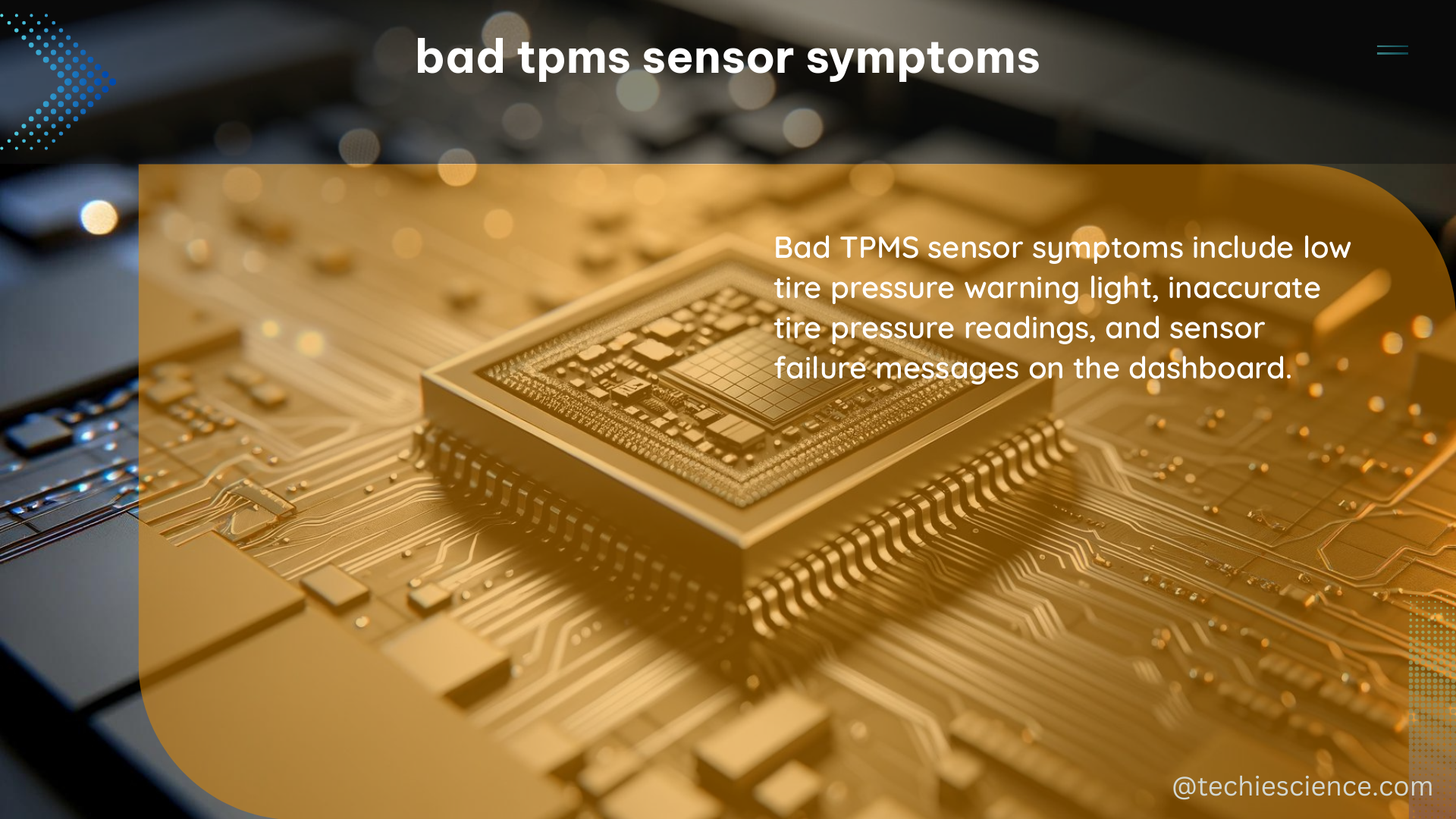Bad TPMS (Tire Pressure Monitoring System) sensor symptoms can include inaccurate tire pressure readings, warning lights on the dashboard, decreased fuel efficiency, and even unexpected tire wear. These issues can be caused by a variety of problems, such as damaged or corroded wiring, a faulty TPMS sensor, or a weak battery in the sensor. Understanding the TPMS system and its components is crucial for diagnosing and resolving these problems effectively.
Understanding the TPMS System
The TPMS system is composed of several key components:
- TPMS Sensors: These are typically located inside the wheels and are responsible for measuring the tire pressure. They transmit this information to the receiver module.
- Receiver Module: This component receives the tire pressure data from the sensors and relays it to the vehicle’s computer.
- Warning Light: When the tire pressure falls below a certain threshold, the TPMS warning light on the dashboard will illuminate to alert the driver.
The TPMS sensors operate on a specific frequency, either 315 MHz or 433 MHz, and have an average battery life of 5-10 years. The receiver module is usually located near the vehicle’s antenna and has a range of approximately 30-50 feet.
Symptoms of a Bad TPMS Sensor

- Inaccurate Tire Pressure Readings:
- Symptoms: The tire pressure displayed on the dashboard or TPMS display may not match the actual tire pressure measured with a tire pressure gauge.
- Causes: Damaged or corroded wiring, a faulty TPMS sensor, or a weak sensor battery.
-
Diagnosis: Use a TPMS tool to scan the sensors and check for any error codes related to the sensor.
-
TPMS Warning Light Illumination:
- Symptoms: The TPMS warning light on the dashboard is illuminated, indicating a problem with the TPMS system.
- Causes: Low tire pressure, a faulty TPMS sensor, or an issue with the receiver module.
-
Diagnosis: Use a TPMS tool to scan the sensors and check for any error codes related to the sensor or receiver module.
-
Decreased Fuel Efficiency:
- Symptoms: The vehicle’s fuel efficiency has decreased, which may be related to the TPMS system.
- Causes: Incorrect tire pressure due to a malfunctioning TPMS system, leading to increased rolling resistance and decreased fuel efficiency.
-
Diagnosis: Check the tire pressure using a tire pressure gauge and compare it to the recommended pressure in the vehicle’s owner’s manual. If the pressure is low, the TPMS system may need to be inspected and repaired.
-
Uneven Tire Wear:
- Symptoms: The tires on the vehicle are wearing unevenly, which may be a sign of a TPMS issue.
- Causes: Incorrect tire pressure due to a malfunctioning TPMS system, leading to uneven tire wear.
- Diagnosis: Inspect the tires for signs of uneven wear, such as one side of the tire wearing faster than the other. Use a tire tread depth gauge to measure the tread depth at different points on the tire.
Diagnosing and Repairing TPMS Issues
To diagnose and repair TPMS issues, follow these steps:
- Use a TPMS tool to scan the sensors and check for any error codes.
- Inspect the wiring and connections for any signs of damage or corrosion.
- Check the battery life of the TPMS sensors, as a weak battery can cause inaccurate readings.
- If a sensor is faulty, it will need to be replaced.
- If the receiver module is malfunctioning, it may need to be replaced as well.
- Ensure that the replacement TPMS sensors are compatible with your vehicle’s make, model, and year.
- After making any repairs, clear any error codes and test the TPMS system to ensure it is functioning correctly.
Technical Specifications and Considerations
- TPMS Sensor Frequency: 315 MHz or 433 MHz
- TPMS Sensor Battery Life: Approximately 5-10 years
- Receiver Module Range: Approximately 30-50 feet
- Tire Pressure Thresholds: Typically 25-35 PSI, depending on the vehicle
It’s important to consult your vehicle’s owner’s manual or the manufacturer’s recommendations for the specific TPMS system and tire pressure requirements.
By understanding the symptoms of a bad TPMS sensor and following the proper diagnostic and repair procedures, you can effectively troubleshoot and resolve TPMS-related issues, ensuring your vehicle’s safety and optimal performance.
References:
– “Onboard Monitoring and Reporting System for Commercial Vehicle” https://path.berkeley.edu/sites/default/files/onboard-monitoring-and-reporting-for-cmv-safety-final-report-dec2007.pdf
– “All of the sudden…I’m burning oil?” https://www.tacomaworld.com/threads/all-of-the-sudden-im-burning-oil.819436/
– “Analysis Techniques for Race Car Data Acquisition” https://www.academia.edu/88089423/Analysis_Techniques_for_Race_Car_Data_Acquisition
– “Federal Motor Vehicle Safety Standards; V2V Communications” https://www.federalregister.gov/documents/2017/01/12/2016-31059/federal-motor-vehicle-safety-standards-v2v-communications
– “2008 GT: sluggish cold start, sometimes stalls” https://www.maseratilife.com/threads/2008-gt-sluggish-cold-start-sometimes-stalls.127453/

The lambdageeks.com Core SME Team is a group of experienced subject matter experts from diverse scientific and technical fields including Physics, Chemistry, Technology,Electronics & Electrical Engineering, Automotive, Mechanical Engineering. Our team collaborates to create high-quality, well-researched articles on a wide range of science and technology topics for the lambdageeks.com website.
All Our Senior SME are having more than 7 Years of experience in the respective fields . They are either Working Industry Professionals or assocaited With different Universities. Refer Our Authors Page to get to know About our Core SMEs.